The Effects and Benefits of Medical Cannabis: Research and Results

Cannabis has been used for medicinal purposes since about 6,000 years ago.
The Chinese surgeon Hua Tuo (140-208 BC) is believed to be the first person to use cannabis for medical purposes. He ground the herb into a powder, mixed it with wine and gave it to people before surgery. Cannabis was thus used as an anesthetic to relieve pain. In addition to China, marijuana was used for treatment in Ancient Egypt, Greece, India, and the Netherlands.
In today's world, scientists continue to study marijuana's ability to inhibit autoimmune diseases: multiple sclerosis, rheumatoid arthritis, inflammatory bowel disease. There are also studies that are determining the role of medical cannabis in treating neurological disorders, such as Alzheimer's disease.
Learn more about the history and geography of medical cannabis here.
Supporters and opponents of marijuana legalization
According to a Hill-HarrisX poll, 84% of Americans support the legalization of marijuana. Forty-two percent of those polled favor legalizing marijuana for any use, with the remaining 42% saying they want legalization for medical purposes.
A small minority, 13%, said marijuana users and distributors should be prosecuted, and 3% said only distributors should be punished by law.
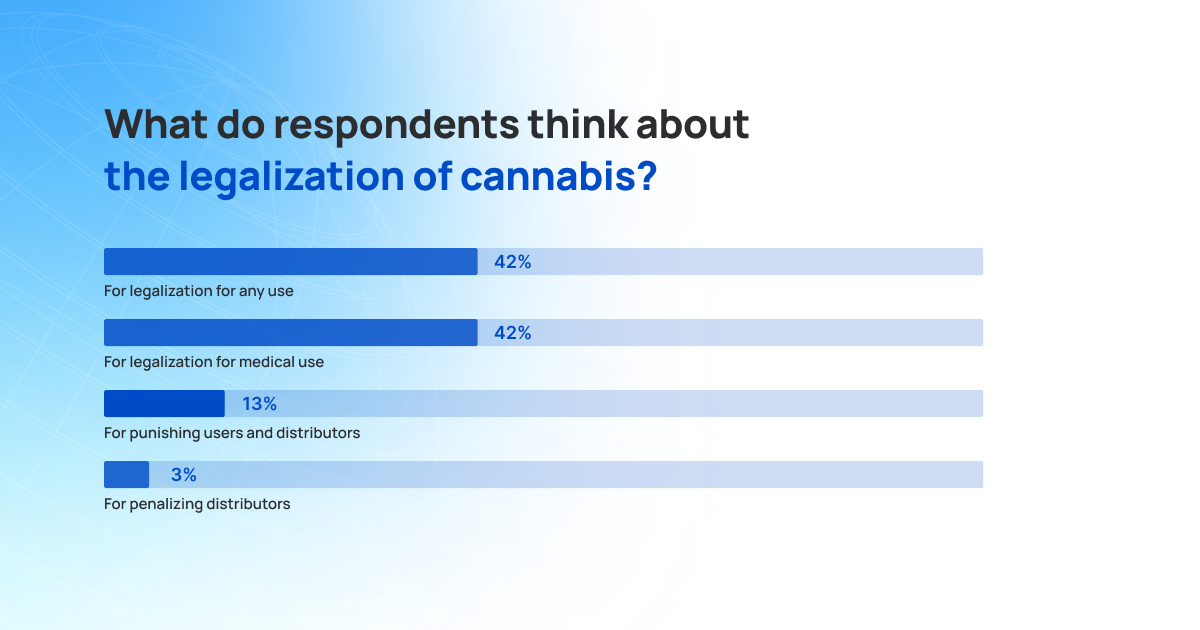
Across all age groups, an overwhelming majority supported legalizing marijuana:
- 50% of respondents aged 35 to 49 support legalizing marijuana for medical treatment;
- 43% of 18- to 34-year-olds said they want pot legalized for all purposes;
- The older generation (ages 50 to 64) is ambivalent about legalizing cannabis. 14% strongly oppose, 33% support legalizing weed for treatment.
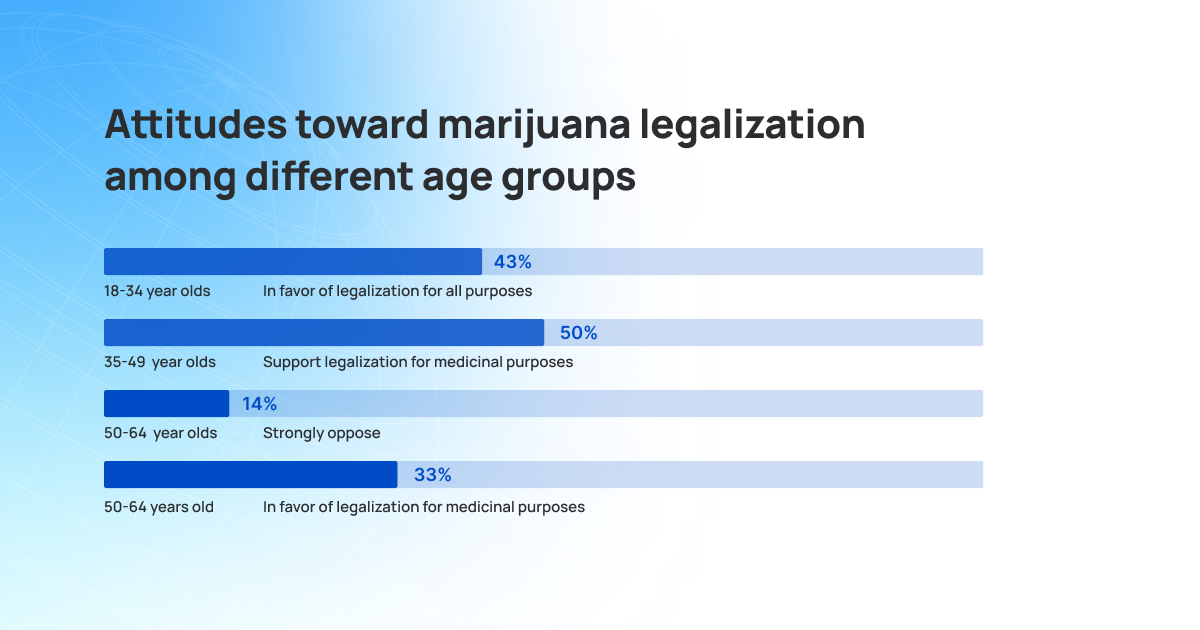
Over the past two decades, there has been an increase in public support for the legalization of marijuana. According to a 2019 Pew Research Center poll, the number supporting legalization has doubled since 2000.
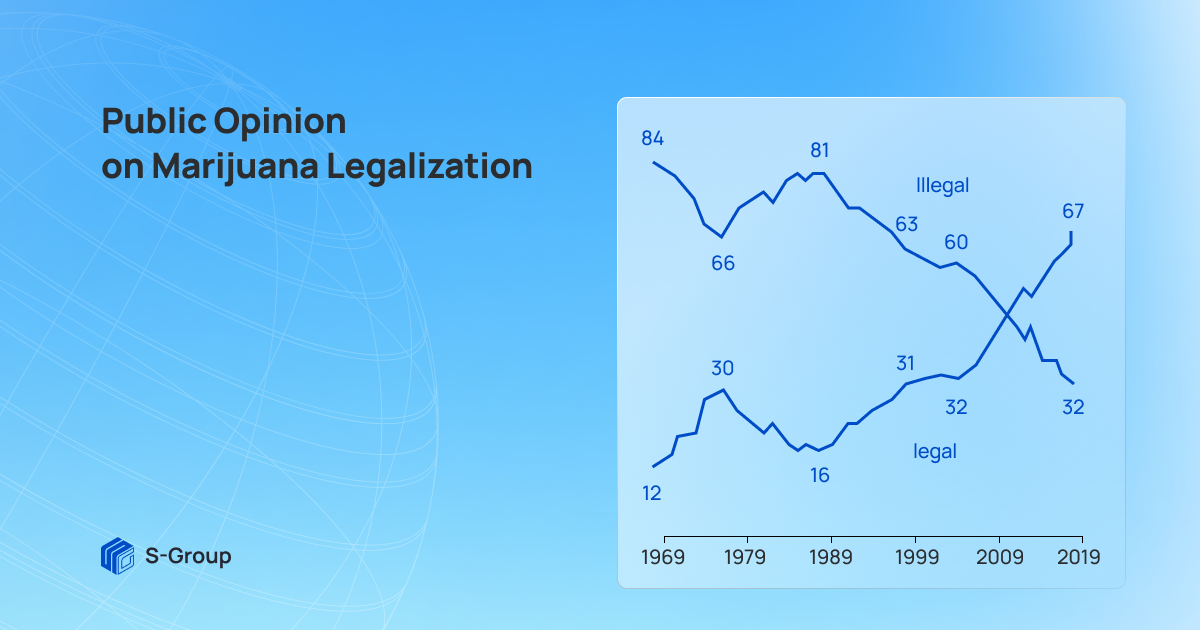
Arguments of supporters and opponents of cannabis legalization
Respondents who were in favor of legalization emphasized the medical benefits of marijuana and said it would help law enforcement focus on other crimes. According to the Gallup poll, 86% and 70%, respectively, found these reasons to be very important to support legalization.
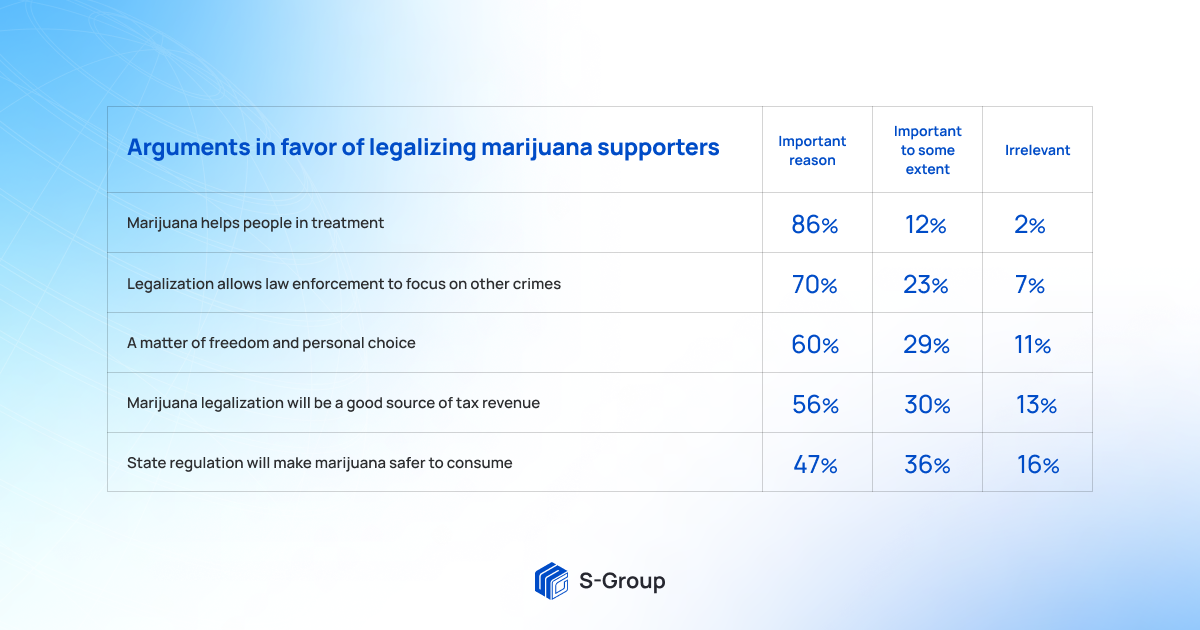
79% of opponents say legalization will lead to more accidents on the roads. 69% believe legalization will cause more people to become addicted to drugs.
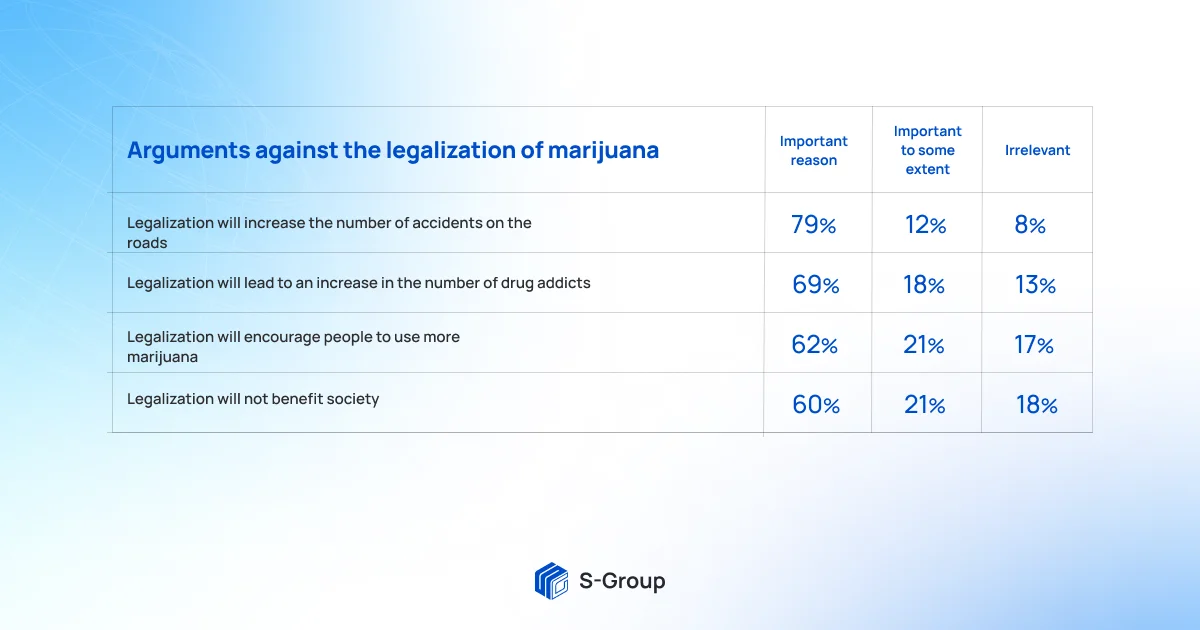
Learn more about which countries have legalized marijuana here.
Cannabis legalization and economics: What you need to know
Economic benefit is one of the motives behind legalization. Increased tax revenue, job growth and investment opportunities are powerful incentives for promoting cannabis legalization.

Increased tax revenues
According to a 2019 report by Arcview Market Research and BDS Analytics, cannabis sales in the U.S. were $12.2 billion, and by 2024, that amount will rise to $31.1 billion. If marijuana becomes legal at the federal level, the nations economies will improve significantly. A report by analyst firm New Frontier indicates that marijuana could generate an additional $105.6 billion in tax revenue by 2025.
New jobs
The legalization of marijuana promotes the creation of new nurseries and dispensaries, which will create new jobs. A study by RCG Economics and Marijuana Policy Group says legalizing cannabis in Nevada will generate more than 41,000 jobs by 2024 and bring in more than $1.7 billion in labor income. And a New Frontier report predicts that nationwide legalization could create one million new jobs by 2025.
Workers will be needed to farm, process, distribute and sell cannabis-based products. There will also be more opportunities for secondary industries that are not involved in cannabis production and distribution. For example, software developers, financial services, etc.
Investment Opportunities
Legalizing marijuana in countries where it is not legal, such as some U.S. states, would help investors protect investment portfolios, as it is difficult to capitalize on the industry right now. If marijuana becomes legal on a national level, companies will be free to list on stock exchanges. By doing so, they would increase liquidity and open up access to profits for many investors.
Medical cannabis: how and what it cures
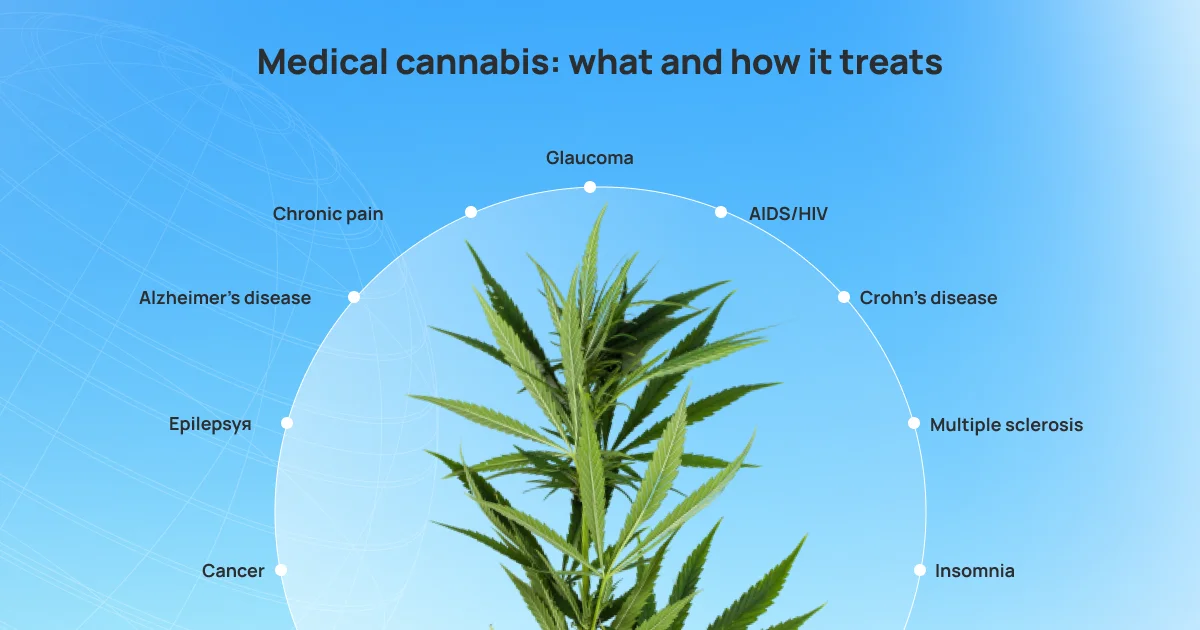
Twenty years ago, scientists discovered endocannabinoid receptors in the human body that respond to 60 chemicals found in marijuana. They also affect the digestive, endocrine, immune, nervous and reproductive systems.
It was at this point that doctors and scientists began to investigate the effects of marijuana on the body during treatment.
The least controversial is cannabidiol cannabis extract (CBD) because it has few intoxicating properties. But tetrahydrocannabinol (THC) is the chemical that gets you high. The medical use of CBD-dominant varieties of marijuana is aimed at pain relief, not intoxicating effects.
Chronic Pain
More than 600,000 Americans use cannabis to relieve chronic pain from diabetes, spinal cord injuries, muscle and joint problems. According to a NASEM report, marijuana reduced pain by 40%. According to the same survey, 79% of seniors have used cannabis for pain due to arthritis.
Insomnia
In a Colorado study, people with sleep disorders used cannabis to sleep and 86% it helped.
AIDS/HIV
In a study conducted on people with HIV, scientists found that patients who used medical cannabis had improved sleep, appetite, mood, and reduced neuropathic pain.
Alzheimer's Disease
Medical marijuana is used to help Alzheimer's patients gain weight. Studies have shown that it reduces agitation in behavior and slows the process of protein deposition in the brain.
Cancer
Laboratory studies on animals have shown that marijuana extract can kill some cancer cells and inhibit growth. But as of 2021, there is no evidence that cannabis helps stop cancer in humans. Marijuana can only stop the nausea that comes from chemotherapy.
Crohn's Disease
A small study involving 13 patients who were followed for three months found that cannabis relieved pain, reduced the frequency of diarrhea and helped people with Crohn's disease gain weight.
Epilepsy
In 2018, The New England Journal conducted a study that showed cannabis reduced seizure frequency by 50 percent in children and adults. But some patients experienced side effects: drowsiness, decreased appetite, diarrhea, vomiting, and upper respiratory tract infection.
Glaucoma
Glaucoma is one of the leading causes of blindness. In 2009, the American Glaucoma Society noted that cannabis reduces intraocular pressure. But it can also lower blood pressure and damage the optic nerve.
Multiple Sclerosis
Marijuana use helps prevent muscle spasms, pain, tremors and stiffness. Cannabis research and development company MMJ International Holdings Corp intends to test an experimental drug, a highly purified liquid, plant extract with THC and CBD in a gelatin capsule to treat multiple sclerosis.
Conclusions
This is not an exhaustive list, but rather a brief overview of diseases for which cannabis can help. As with all medicines, claims of effectiveness should be evaluated critically and treated with caution.
The cannabis industry is actively developing, and we can already see a positive trend in the attitudes of society, scientists, and doctors towards medical marijuana. Studies show that the legalization of cannabis will have a positive impact on economic indicators, such as increasing the number of jobs, and helping people with serious illnesses relieve their symptoms.
The market is now on the cusp of cannabis legalization. Patient demand for medical cannabis is three times greater than supply. At S-PHARMACEUTICAL you have a unique opportunity to join a publicly traded company and be part of a great production with the company.
Share
Interesting
Would you like to receive a digest of articles?
One email with the best articles of the week.
Sign up so you don't miss anything.